Lesson 1: Connectivity Devices
This lesson is devoted to the hardware that is used to expand networks. We begin with the most basic communication device: the modem. Modems have become so common that they are standard equipment on most computers sold today. Indeed, anyone who has ever used the Internet or a fax machine has used a modem. In addition to modems, several devices are used to connect small LANs into larger wide area networks (WANs). Each of these devices has its own function along with some limitations. They can be used simply to extend the length of network media or to provide access to a worldwide network over the Internet. Devices used to expand LANs include repeaters, bridges, routers, brouters, and gateways.
After this lesson, you will be able to:
- Describe the basic functions of a modem.
- Identify modem standards.
- Describe the function of repeaters, bridges, routers, brouters, and gateways.
Estimated lesson time: 65 minutes
Modem Technology
A modem is a device that makes it possible for computers to communicate over a telephone line.
When computers are too far apart to be joined by a standard computer cable, a modem can enable communication between them. Remember from Chapter 2, "Basic Network Media," that network cables are limited in length. In a network environment, modems serve as a means of communication between networks and as a way to connect to the world beyond the local network.

Run the c07dem01 video located in the Demos folder on the CD accompanying this book to view a presentation of how a modem makes it possible for computers to communicate over a telephone line.
Basic Modem Functions
Computers cannot simply be connected to each other over a telephone line, because computers communicate by sending digital electronic pulses (electronic signals), and a telephone line can send only analog waves (sound). Figure 7.1 shows the difference between digital computer communication and analog telephone communication.

Figure 7.1 Digital signals versus analog waves
A digital signal has a binary form. The signal can have a value of either 0 or 1. An analog signal can be pictured as a smooth curve that can represent an infinite range of values.

Run the c07dem02, c07dem03, and c07dem04 videos located in the Demos folder on the CD accompanying this book for an illustrated overview of modem functions.
As shown in Figure 7.2, the modem at the sending end converts the computer's digital signals into analog waves and transmits the analog waves onto the telephone line. A modem at the receiving end converts the incoming analog signals back into digital signals for the receiving computer.
In other words, a sending modem MOdulates digital signals into analog signals, and a receiving modem DEModulates analog signals back into digital signals.
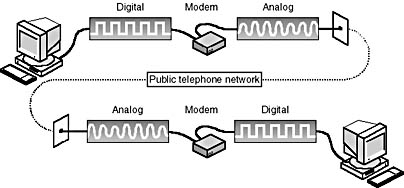
Figure 7.2 Modems convert digital signals to analog waves, and convert analog waves to digital signals
NOTE
To use digital lines, you must install a special digital card in the computer.
Modem Hardware
Modems are known as data communications equipment (DCE) and share the following characteristics:
- A serial (RS-232) communications interface
- An RJ-11 telephone-line interface (a four-wire telephone plug)

Run the c07dem05 video located in the Demos folder on the CD accompanying this book to view a presentation of modem cable interfaces.
Modems are available in both internal and external models. An internal modem, as shown in Figure 7.3, is installed in a computer's expansion slot like any other circuit board.

Run the c07dem06 video located in the Demos folder on the CD accompanying this book to view a presentation of internal modems.
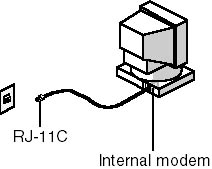
Figure 7.3 Internal modem installed in an expansion slot
An external modem, as shown in Figure 7.4, is a small box that is connected to the computer by a serial (RS-232) cable running from the computer's serial port to the modem's computer cable connection. The modem uses a cable with an RJ-11C connector to connect to the wall.

Figure 7.4 External modem connects through the RS-232 cable to the computer serial port

Run the c07dem07 video located in the Demos folder on the CD accompanying this book to view a presentation of external modems.
Modem Standards
Standards are necessary so that modems from one manufacturer can communicate with modems from another manufacturer. This section explains some of the common industry standards for modems.
Hayes-Compatible
In the early 1980s, a company called Hayes Microcomputer Products developed a modem called the Hayes Smartmodem. The Smartmodem became the standard against which other modems were measured, and generated the phrase "Hayes-compatible," just as IBM's personal computer generated the term "IBM-compatible." Because most vendors conformed to the Hayes standards, nearly all LAN modems could communicate with each other.
The early Hayes-compatible modems sent and received data at 300 bits per second (bps). Modem manufacturers currently offer modems with speeds of 56,600 bps or more.
International Standards
Since the late 1980s, the International Telecommunications Union (ITU) has developed standards for modems. These specifications, known as the V series, include a number that indicates the standard. As a reference point, the V.22bis modem at 2400 bps would take 18 seconds to send a 1000-word letter. The V.34 modem at 9600 bps would take only four seconds to send the same letter, and the V.42bis compression standard in a 14,400 bps modem can send the same letter in only three seconds.
The chart in Table 7.1 presents the compression standards and their parameters since 1984. The compression standard and the bps are not necessarily related. The standard could be used with any speed of modem.
Table 7.1 Modem Compression Standards from 1984 to the Present
| Standard | bps | Introduced | Notes |
|---|---|---|---|
| V.22bis | 2400 | 1984 | |
| V.32 | 9600 | 1984 | |
| V.32bis | 14,400 | 1991 | |
| V.32terbo | 19,200 | 1993 | Will communicate only with another V.32terbo |
| V.FastClass (V.FC) | 28,800 | 1993 | |
| V.34 | 28,800 | 1994 | Improved V.FastClass. Backward-compatible with earlier V. modems |
| V.42 | 57,600 | 1995 | Backward-compatible with earlier V. modems—error-correction standard |
| V.90 | 56,600 | 1998 | 56K modem standard; resolved competition for standard between U.S. Robotic X2 and Rockwell K56 Flex standards. |
Modem Performance
Initially, a modem's speed was measured in either bps or something called the "baud rate," and most people mistakenly assumed the two were identical.
"Baud" refers to the speed at which the sound wave that carries a bit of data over the telephone lines oscillates. The term derives from the name of French telegrapher and engineer Jean-Maurice-Emile Baudot. In the early 1980s, the baud rate did equal the transmission speed of modems. At that time, 300 baud equaled 300 bits per second.
Eventually, communications engineers learned to compress and encode data so that each modulation of sound could carry more than one bit of data. This development means that the rate of bps can be greater than the baud rate. For example, a modem that modulates at 28,800 baud can actually send at 115,200 bps. Therefore, the current parameter to look for in modem speed is bps.
Several of the newer modems feature industry standards, such as V.42bis/MNP5 data compression, and have transmission speeds of 57,600 bps; and some modems go up to 76,800 bps.
Types of Modems
There are different types of modems because different types of communication environments require different methods of sending data. These environments can be divided roughly into two areas related to the timing of communications:
- Asynchronous
- Synchronous
The type of modem a network uses depends on whether the environment is asynchronous or synchronous.
Asynchronous Communication (Async)
Asynchronous communication, known as "async," is possibly the most widespread form of connectivity in the world. This is because async was developed in order to make use of common telephone lines.
Figure 7.5 shows an asynchronous environment, in which data is transmitted in a serial stream.

Figure 7.5 Asynchronous serial data stream
Each character—letter, number, or symbol—is turned into a string of bits. Each of these strings is separated from the other strings by a start-of-character bit and a stop bit. Both the sending and receiving devices must agree on the start and stop bit sequence. The receiving computer uses the start and stop bit markers to schedule its timing functions so it is ready to receive the next byte of data.
Communication is not synchronized. There is no clocking device or method to coordinate transmission between the sender and the receiver. The sending computer just sends data, and the receiving computer just receives data. The receiving computer then checks to make sure that the received data matches what was sent. Between 20 and 27 percent of the data traffic in async communication consists of data traffic control and coordination. The actual amount depends on the type of the transmission—for example, whether parity (a form of error checking, discussed in the section that follows) is being used.
Asynchronous transmission over telephone lines can happen at up to 28,800 bps. However, the latest data compression methods can boost the 28,800 bps rate to 115,200 bps over directly connected systems.

Run the c07dem08 and c07dem09 videos located in the Demos folder on the CD accompanying this book for an overview of asynchronous communication.
Error Control Because of the potential for error, async can include a special bit, called a parity bit, which is used in an error-checking and correction scheme called parity checking. In parity checking, the number of bits sent must match exactly the number of bits received.

Run the c07dem10 video located in the Demos folder on the CD accompanying this book to view a presentation of parity bits in asynchronous communication.
The original V.32 modem standard did not provide error control. To help avoid generating errors during data transmission, a company called Microcom developed its own standard for asynchronous data-error control, the Microcom Networking Protocol (MNP). The method worked so well that other companies adopted not only the initial version of the protocol but later versions, called classes, as well. Currently, several modem manufacturers incorporate MNP Classes 2, 3, and 4 standards.
In 1989, the Comité Consultatif Internationale de Télégraphie et Téléphonie (CCITT) published an asynchronous error-control scheme called V.42. This hardware-implemented standard featured two error-control protocols. The primary error-control scheme is link access procedure for modems (LAPM), but the scheme also uses MNP Class 4. The LAPM protocol is used in communications between two modems that are V.42-compliant. If only one, but not both, of the modems is MNP 4compliant, the correct protocol to use would be MNP 4.
Improving Transmission Performance Communication performance depends on two elements:
- Signaling or channel speed describes how fast the bits are encoded onto the communications channel.
- Throughput measures the amount of useful information going across the channel.

Run the c07dem11 video located in the Demos folder on the CD accompanying this book to view a presentation of channel speed and throughput.
By removing redundant elements or empty sections, compression improves the time required to send data. Microcom's MNP Class 5 Data Compression Protocol is an example of one current data compression standard. You can improve performance, often doubling the throughput, by using data compression. When both ends of a communication link use the MNP Class 5 protocol, data transmission time can be cut in half.

Run the c07dem12 video located in the Demos folder on the CD accompanying this book to view a presentation of data compression.
The V.42bis standard, because it describes how to implement impressive data compression in hardware, makes even greater performance possible. For example, a 56.6Kbps modem using V.90 can achieve a throughput of 100Kbps.
NOTE
Although compressing data can improve performance, it is not an exact science. Many factors affect the actual compression ratio of a document or file. A text file, for example, can be compressed more effectively than a complex graphic file. It is even possible to have a compressed file that is actually larger than the original. Remember, compression numbers cited by vendors are usually based on a best-case scenario.
Coordinating the Standards Asynchronous, or serial, modems are less expensive than synchronous modems because the asynchronous modem does not need the circuitry and the components to handle the timing involved in synchronous transmission that synchronous modems require.
Synchronous Communication
Synchronous communication relies on a timing scheme coordinated between two devices to separate groups of bits and transmit them in blocks known as "frames." Special characters are used to begin the synchronization and check its accuracy periodically.

Run the c07dem13 and c07dem14 videos located in the Demos folder on the CD accompanying this book for an overview of synchronous communication.
Because the bits are sent and received in a timed, controlled (synchronized) process, start and stop bits are not required. Transmission stops at the end of one frame and starts again with a new one. This start-and-stop approach is much more efficient than asynchronous transmission, especially when large packets of data are being transferred. When small packets are sent, this increase in efficiency is less noticeable. Figure 7.6 shows a comparison of asynchronous and synchronous data streams.
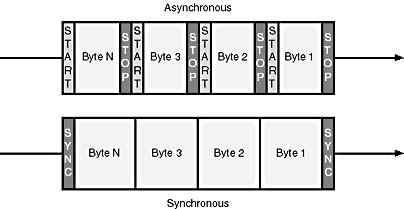
Figure 7.6 Asynchronous data stream versus synchronous data stream
If there is an error, the synchronous error-detection and correction scheme implements a retransmission.

Run the c07dem15 video located in the Demos folder on the CD accompanying this book to view a presentation of a synchronous communication error-correction scheme.
Synchronous protocols perform a number of jobs that asynchronous protocols do not. Principally, they:
- Format data into blocks.
- Add control information.
- Check the information to provide error control.
The primary protocols in synchronous communication are:
- Synchronous Data Link Control (SDLC).
- High-level Data Link Control (HDLC)
- Binary Synchronous Communications Protocol (bisync)
Synchronous communication is used in almost all digital and network communications. For example, if you were using digital lines to connect remote computers, you would use synchronous modems rather than asynchronous modems to connect the computer to the digital line. Generally, their higher cost and complexity have kept synchronous modems out of the home market.
Asymmetric Digital Subscriber Line (ADSL)
The latest modem technology to become available is asymmetric digital subscriber line (ADSL). This technology converts existing twisted-pair telephone lines into access paths for multimedia and high-speed data communications. These new connections can transmit more than 8 Mbps to the subscriber and up to 1 Mbps from the subscriber.
ADSL is not without drawbacks. The technology requires special hardware, including an ADSL modem on each end of the connection. It also requires broadband cabling, which is currently only available in a few locations, and there is a limit to the connection length.
ADSL is recognized as a physical layer transmission protocol for unshielded twisted-pair media.
Expanding a Network Using Components
As companies grow, so do their networks. LANs tend to outgrow their original designs. You know your LAN is too small when:
- The cable begins to get crowded with network traffic.
- Print jobs include longer wait times.
- Traffic-generating applications, such as databases, experience increased response times.
The time usually comes when administrators need to expand the size or improve the performance of their networks. But networks cannot be made larger merely by adding new computers and more cable. Each topology or architecture has limits. There are, however, components that can be installed to increase the size of the network within its existing environment. These components can:
- Segment existing LANs so that each segment becomes its own LAN.
- Join two separate LANs.
- Connect to other LANs and computing environments to join them into a larger comprehensive WAN.
The components that enable engineers to accomplish these goals are:
- Hubs.
- Repeaters.
- Bridges.
- Routers.
- Brouters.
- Gateways.
Hubs
Chapter 2, "Basic Network Media," discusses how a hub is used as the central hardware component in a star topology. Chapter 3, "Understanding NetworkArchitecture," discusses how a hub works with a token-ring topology. Hubs can also be used to expand the size of a LAN. Although using hubs won't convert a LAN into a WAN, connecting or adding hubs to a LAN can effectively increase the number of workstations. This method of growing a LAN is popular, but does come with many design limitations. Figure 7.7 shows how several 10BaseT hubs can be connected to expand a network.
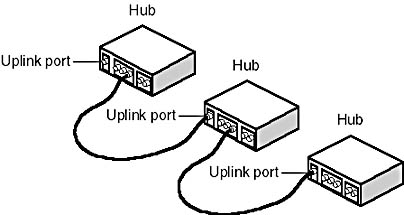
Figure 7.7 Ethernet hubs connected in a series
Figure 7.8 shows how several token-ring hubs can be connected to expand a network.

Figure 7.8 Token-ring hubs connected into one large ring
NOTE
It is important to be careful when connecting hubs. Crossover cables are wired differently than standard patch cables, and one will not work correctly in place of the other. Check with the manufacturers to determine whether you need a standard patch cable or a crossover cable.
Repeaters
As signals travel along a cable, they degrade and become distorted in a process called "attenuation." (Attenuation is discussed in Chapter 2, "Basic NetworkMedia.") If a cable is long enough, attenuation will finally make a signal unrecognizable. Installing a repeater enables signals to travel farther.
How Repeaters Work
A repeater works at the physical layer of the OSI Reference Model to regenerate the network's signals and resend them out on other segments. Figure 7.9 shows how repeaters regenerate weak signals.

Figure 7.9 Repeaters regenerate weakened signals
The repeater takes a weak signal from one segment, regenerates it, and passes it to the next segment. To pass data through the repeater from one segment to the next, the packets and the Logical Link Control (LLC) protocols must be identical on each segment. A repeater will not enable communication, for example, between an 802.3 LAN (Ethernet) and an 802.5 LAN (Token Ring).
Repeaters do not translate or filter signals. For a repeater to work, both segments that the repeater joins must use the same access method. The two most common access methods are carrier-sense multiple-access with collision detection (CSMA/CD) and token passing (discussed in Chapter 3, "Understanding Network Architecture"). A repeater cannot connect a segment using CSMA/CD to a segment using the token-passing access method. That is, a repeater cannot translate an Ethernet packet into a Token Ring packet.
As shown in Figure 7.10, repeaters can move packets from one kind of physical media to another. They can take an Ethernet packet coming from a thinnet coaxial-cable segment and pass it on to a fiber-optic segment, provided the repeater is capable of accepting the physical connections.

Figure 7.10 Repeaters can connect different types of media
Some multiport repeaters act as multiport hubs and connect different types of media. The same segment limits discussed in Chapter 3 apply to networks that use hubs, but the limits now refer to each segment extending from a hub rather than to the entire network.
Repeater Considerations
Repeaters afford the least expensive way to expand a network. When the need arises to extend the physical network beyond its distance or node limitations, consider using a repeater to link segments if neither segment is generating much traffic or limiting costs is a major consideration.
No Isolation or Filtering Repeaters send every bit of data from one cable segment to another, even if the data consists of malformed packets or packets not destined for use on the network. This means that a problem with one segment can disrupt every other segment. Repeaters do not act as filters to restrict the flow of problem traffic.
Repeaters will also pass a broadcast storm along from one segment to the next, back and forth along the network. A broadcast storm occurs when so many broadcast messages are on the network that the number is approaching the network bandwidth limit. If a device is responding to a packet that is continuously circulating on the network, or a packet is continuously attempting to contact a system that never replies, network performance will be degraded.
Implementing a repeater This section summarizes what you need to consider when deciding whether to implement repeaters in your network.
Use a repeater to:
- Connect two segments of similar or dissimilar media.
- Regenerate the signal to increase the distance transmitted.
- Pass all traffic in both directions.
- Connect two segments in the most cost-effective manner.
NOTE
Repeaters improve performance by dividing the network into segments, thus reducing the number of computers per segment. When using repeaters to expand a network, don't forget about the 5-4-3 rule (introduced in Chapter 3, "Understanding Network Architecture").
Do not use a repeater when:
- There is heavy network traffic.
- Segments are using different access methods.
- Data filtering is needed.
Bridges
Like a repeater, a bridge can join segments or workgroup LANs. Figure 7.11 shows a bridge connecting two network segments. However, a bridge can also divide a network to isolate traffic or problems. For example, if the volume of traffic from one or two computers or a single department is flooding the network with data and slowing down the entire operation, a bridge could isolate those computers or that department.
Bridges can be used to:
- Expand the length of a segment.
- Provide for an increased number of computers on the network.
- Reduce traffic bottlenecks resulting from an excessive number of attached computers.
- Split an overloaded network into two separate networks, reducing the amount of traffic on each segment and making each network more efficient.
- Link unlike physical media such as twisted-pair and coaxial Ethernet.

Figure 7.11 A bridge connecting two networks
How Bridges Work
Because bridges work at the data-link layer of the OSI reference model, all information contained in the higher levels of the OSI reference model is unavailable to them. Rather than distinguish between one protocol and another, bridges simply pass all protocols along the network. All protocols pass across bridges, so it is up to the individual computers to determine which protocols they can recognize.
As discussed in Chapter 5, "Introducing Network Standards," the data-link layer has two sublayers: the Logical Link Control (LLC) sublayer and the Media Access Control (MAC) sublayer. Bridges work at the MAC sublayer and are sometimes referred to as MAC-layer bridges.
A MAC-layer bridge:
- Listens to all traffic.
- Checks the source and destination addresses of each packet.
- Builds a routing table, as information becomes available.
- Forwards packets in the following manner:
- If the destination is not listed in the routing table, the bridge forwards the packets to all segments.
- If the destination is listed in the routing table, the bridge forwards the packets to that segment (unless it is the same segment as the source).
A bridge works on the principle that each network node has its own address. A bridge forwards packets based on the address of the destination node.
Bridges actually have some degree of intelligence in that they learn where to forward data. As traffic passes through the bridge, information about the computer addresses is stored in the bridge's RAM. The bridge uses this RAM to build a routing table based on source addresses.
Initially, the bridge's routing table is empty. As nodes transmit packets, the source address is copied to the routing table. With this address information (See Figure 7.12), the bridge learns which computers are on which segment of the network.
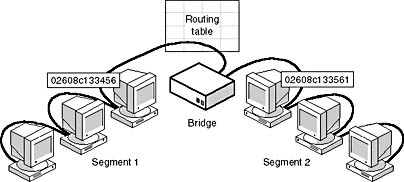
Figure 7.12 The routing table keeps track of addresses
Creating the Routing Table Bridges build their routing tables based on the addresses of computers that have transmitted data on the network. Specifically, bridges use source addresses—the address of the device that initiates the transmission—to create a routing table.
When the bridge receives a packet, the source address is compared to the routing table. If the source address is not there, it is added to the table. The bridge then compares the destination address with the routing-table database.
- If the destination address is in the routing table and is on the same segment as the source address, the packet is discarded. This filtering helps to reduce network traffic and isolate segments of the network.
- If the destination address is in the routing table and not in the same segment as the source address, the bridge forwards the packet out of the appropriate port to reach the destination address.
- If the destination address is not in the routing table, the bridge forwards the packet to all its ports except the one on which it originated.
In summary, if a bridge knows the location of the destination node, it forwards the packet to it. If it does not know the destination, it forwards the packet to all segments.
Segmenting Network Traffic A bridge can segment traffic because of its routing table. As shown in Figure 7.13, a computer on segment 1 (the source), sends data to another computer (the destination) also located in segment 1. If the destination address is in the routing table, the bridge can determine that the destination computer is also on segment 1. Because the source and destination computers are both on segment 1, the packet does not get forwarded across the bridge to segment 2.
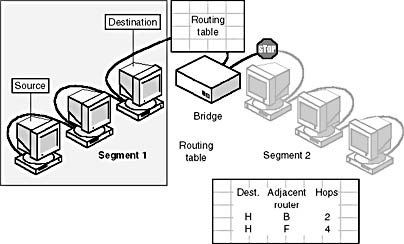
Figure 7.13 The routing table allows bridges to segment networks
Therefore, bridges can use routing tables to reduce the traffic on the network by controlling which packets get forwarded to other segments. This controlling (or restricting) of the flow of network traffic is known as "segmenting network traffic."
A large network is not limited to one bridge. Multiple bridges can be used to combine several small networks into one large network.
Remote Bridges
Because bridges can be such powerful tools in expanding and segmenting networks, they are often used in large networks that have widely dispersed segments joined by telephone lines.
Only one bridge is necessary to link two cable segments. However, where two separate LANs are located at a great distance from each other (See Figure 7.14), they can be joined into a single network. Implementing two remote bridges connected with synchronous modems to a dedicated, data-grade telephone line can do this.
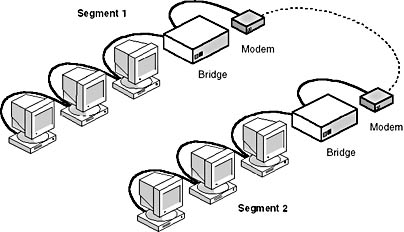
Figure 7.14 Remote bridges can be used to connect remote segments
Because remote LAN segments can be joined over telephone lines, it is possible for multiple LANs to be joined by more than one path. In this situation, it is possible that data might get into a continuous loop. To handle this possibility, the 802.1 Network Management Committee of the Institute of Electrical and Electronic Engineers (IEEE) has implemented the spanning tree algorithm (STA). Under STA, software can sense the existence of more than one route, determine which would be the most efficient, and then configure the bridge to use that one. Other paths are disconnected using software, although the disconnected routes can be reactivated if the primary route becomes unavailable.
Differentiating Between Bridges and Repeaters
Bridges work at a higher OSI layer than repeaters. This means that bridges have more intelligence than repeaters and can take more data features into account.
While bridges resemble repeaters in that they can regenerate data, bridges do this at the packet level. This means that bridges can send packets over long distances using a variety of long-distance media.
Bridge Considerations
Bridges have all of the features of repeaters, but also accommodate more nodes. They provide better network performance than repeaters. Because bridged networks have been divided, fewer computers compete for available resources on each segment.
To look at it another way, if a large Ethernet network were divided into two segments connected by a bridge, each new network would carry fewer packets, have fewer collisions, and operate more efficiently. Although each network would be separate, the bridge would pass appropriate traffic between them.
Implementing a bridge
A bridge can be either a separate, stand-alone piece of equipment (an external bridge) or it can be installed in a server. If the network operating system (NOS) supports it, one or more network interface cards (NICs), making an internal bridge, can be installed.
Network administrators like to use bridges because they are:
- Simple to install and transparent to users.
- Flexible and adaptable.
- Relatively inexpensive.
Routers
In an environment that consists of several network segments with differing protocols and architectures, a bridge might be inadequate for ensuring fast communication among all segments. A network this complex needs a device that not only knows the address of each segment, but can also determine the best path for sending data and filtering broadcast traffic to the local segment. Such a device is called a "router."
Routers work at the network layer of the OSI reference model. This means they can switch and route packets across multiple networks. They do this by exchanging protocol-specific information between separate networks. Routers read complex network addressing information in the packet and, because they function at a higher layer in the OSI reference model than bridges, they have access to additional information.
Routers can provide the following functions of a bridge:
- Filtering and isolating traffic
- Connecting network segments
Routers have access to more of the information in packets than bridges have and use this information to improve packet deliveries. Routers are used in complex networks because they provide better traffic management. Routers can share status and routing information with one another and use this information to bypass slow or malfunctioning connections.
How Routers Work
Routers maintain their own routing tables, usually consisting of network addresses; host addresses can also be kept if the network architecture calls for it. To determine the destination address for incoming data, the routing table includes:
- All known network addresses.
- Instructions for connection to other networks.
- The possible paths between routers.
- The costs of sending data over those paths.
As shown in Figure 7.15, a router uses its data-routing table to select the best route for the data based on costs and available paths.
NOTE
Remember that routing tables were also discussed in the context of bridges. The routing table maintained by a bridge contains MAC-sublayer addresses for each node, whereas the routing table maintained by a router contains network numbers. Although manufacturers of both types of equipment have chosen to use the term "routing table," it has a different meaning for bridges than it does for routers.
Routers require specific addresses. They understand only the network numbers that allow them to communicate with other routers and local NIC addresses. Routers do not talk to remote computers.
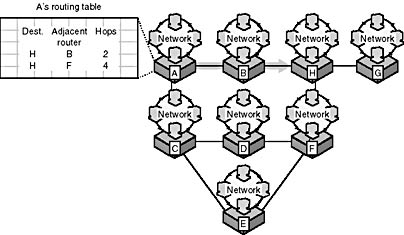
Figure 7.15 Routers talk to other routers, but not to remote computers
When routers receive packets destined for a remote network, they send them to the router that manages the destination network. In some ways this is an advantage because it means routers can:
- Segment large networks into smaller ones.
- Act as safety barriers between segments.
- Prohibit broadcast storms, because broadcasts are not forwarded.
Because routers must perform complex functions on each packet, routers are slower than most bridges. As packets are passed from router to router, data-link layer source and destination addresses are stripped off and then re-created. This enables a router to route a packet from a TCP/IP Ethernet network to a server on a TCP/IP Token Ring network.
Because routers read only addressed network packets, they do not allow corrupted data to get passed onto the network. Because they do not pass corrupted data or broadcast data storms, routers put little stress on networks.
Routers do not look at the destination node address; they look only at the network address. Routers will pass information only if the network address is known. This ability to control the data passing through the router reduces the amount of traffic between networks and allows routers to use these links more efficiently than bridges.
Using the router-addressing scheme, administrators can break one large network into many separate networks, and because routers do not pass or even handle every packet, they act as a safety barrier between network segments. This can greatly reduce the amount of traffic on the network and the wait time experienced by users.
Routable Protocols Not all protocols are routable. Protocols that are routable include:
- DECnet.
- Internet Protocol (IP).
- Internetwork Packet Exchange (IPX).
- OSI.
- Xerox Network System (XNS).
- DDP (AppleTalk).
Protocols that are not routable include:
- Local Area Transport Protocol (LAT), a protocol from Digital Equipment Corporation.
- NetBEUI (NetBIOS Extended User Interface).
Routers are available that can accommodate multiple protocols such as IP and DECnet in the same network.
Choosing Paths Unlike bridges, routers can accommodate multiple active paths between LAN segments and choose among redundant paths. Because routers can link segments that use completely different data packaging and media-access schemes, there are often several paths available for the router to use. This means that if one router does not function, the data can still be passed over alternate routes.
A router can listen to a network and identify which parts are busiest. It uses this information to determine which path to send data over. If one path is very busy, the router identifies an alternative path and sends data over that one.
A router decides the path the data packet will follow by determining the number of hops between internetwork segments. Like bridges, routers build routing tables and use these in routing algorithms such as the following:
- OSPF ("open shortest path first") is a link-state routing algorithm. Link-state algorithms control the routing process and allow routers to respond quickly to changes in the network.
- RIP (Routing Information Protocol) uses distance-vector algorithms to determine routes. Transmission Control Protocol/Internet Protocol (TCP/IP) and IPX support RIP.
- NetWare Link Services Protocol (NLSP) is a link-state algorithm to be used with IPX.
Types of Routers
The two major types of routers are:
- Static.
- Dynamic.
Static routers require an administrator to manually set up and configure the routing table and to specify each route.
Dynamic routers are designed to discover routes automatically and therefore require a minimal amount of setup and configuration. More sophisticated than static routers, they examine information from other routers and make packet-by-packet decisions about how to send data across the network.
Table 7.2 compares and contrasts the characteristics of static and dynamic routers.
Table 7.2 Characteristics of the Two Types of Routers
| Static routers | Dynamic routers |
|---|---|
| Manually set up and configure all routes. | Manually configure the first route. Automatically detect additional networks and routes. |
| Always use the same route, determined by a routing table entry. | Can choose a route based on factors such as cost and amount of link traffic. |
| Use a hard-coded route (designed to handle only a specific situation), not necessarily the shortest route. | Can decide to send packets over alternate routes. |
| Are considered more secure because the administrator specifies each route. | Can improve security by manually configuring the router to filter out specific network addresses and prevent traffic from going there. |
Distinguishing Between Bridges and Routers
Bridges and routers can be confusing even for engineers with LAN and WAN experience because they appear to do the same things: both forward packets between networks and send data across WAN links.
A question often asked is how to decide when to use a bridge and when to use a router.
The bridge, which works at the MAC sublayer of the OSI data-link layer, sees only a node address. To be more specific, a bridge looks for a node's MAC-sublayer address in each packet. If the bridge recognizes the address, it keeps the packet local or forwards it to the appropriate segment. If the bridge does not recognize the address, it forwards the packet to all segments except the one through which the packet arrived.
The bridge first either recognizes the packet's MAC-sublayer address, or it does not, and then it forwards the packet appropriately. Figure 7.16 shows a bridge and a router and how they relate to the OSI reference model.

Figure 7.16 Bridges work at the data-link layer MAC sublayer, and routers work at the network layer
Broadcasting Forwarding the packet is the key to understanding bridges and distinguishing them from routers. With bridges, forwarded broadcast data goes out to every computer from all ports of the bridge except the one through which the packet arrived. That is, each computer on all networks (except the local network from which the broadcast originated) receives a broadcast packet. In small networks this might not have much of an impact, but a large network can generate enough broadcast traffic to slow down a network even though it is filtering for network addresses.
The router, which works at the network layer, takes more information into account than the bridge does, determining not only what to forward but where to forward it. The router recognizes not only an address, as the bridge does, but a type of protocol as well. Additionally, the router can identify the addresses of other routers and determine which packets to forward to which routers.
Multiple Paths A bridge can recognize only one path between networks. A router can search among multiple active paths and determine which is the best path at that particular moment.
As illustrated in Figure 7.17, if router A has a transmission that needs to be sent to router D, it can send the message to router C or to router B, and the message will be forwarded to router D. Routers have the ability to evaluate both paths and determine which would be the best route for that transmission.
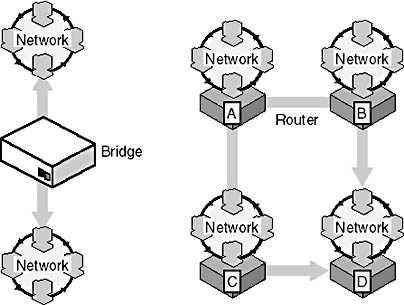
Figure 7.17 Routers recognize and use multiple paths between destinations
Conclusion Four key pieces of information can help you distinguish between a bridge and a router and determine which would be appropriate in a given situation:
- The bridge recognizes only local MAC-sublayer addresses (the addresses of NICs in its own segment). Routers recognize network addresses.
- The bridge broadcasts (forwards) everything it does not recognize and forwards all addresses it knows, but only from the appropriate port.
- The router works only with routable protocols.
- The router filters addresses. It forwards particular protocols to particular addresses (other routers).
Brouters
A brouter, as the name implies, combines the qualities of both a bridge and a router. A brouter can act as a router for one protocol and as a bridge for all the others.
Brouters can:
- Route selected routable protocols.
- Bridge nonroutable protocols.
- Deliver more cost-effective and more manageable internetworking than separate bridges and routers.
Gateways
Gateways enable communication between different architectures and environments. They repackage and convert data going from one environment to another so that each environment can understand the other environment's data. A gateway repackages information to match the requirements of the destination system. Gateways can change the format of a message so that it conforms to the application program at the receiving end of the transfer. For example, electronic-mail gateways, such as the X.400 gateway, receive messages in one format, translate it, and forward it in X.400 format used by the receiver, and vice versa.
A gateway links two systems that do not use the same:
- Communication protocols.
- Data-formatting structures.
- Languages.
- Architecture.
Gateways interconnect heterogeneous networks; for example, they can connect Microsoft Windows NT Server to IBM's Systems Network Architecture (SNA). Gateways change the format of the data to make it conform to the application program at the receiving end.
How Gateways Work
Gateways are task-specific, which means that they are dedicated to a particular type of transfer. They are often referred to by their task name (Windows NT Server to SNA gateway).
As shown in Figure 7.18, a gateway takes the data from one environment, strips off its old protocol stack, and repackages it in the protocol stack from the destination network.
To process the data, the gateway:
- Disassembles incoming data through the network's complete protocol stack.
- Encapsulates the outgoing data in the complete protocol stack of the other network to allow transmission.
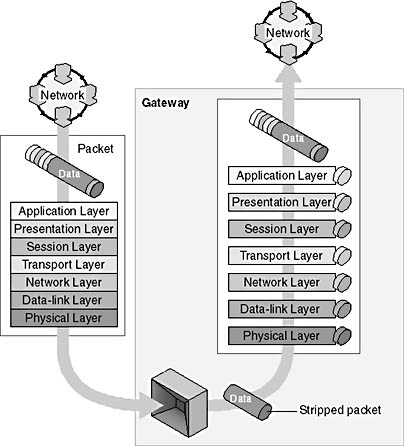
Figure 7.18 Gateways strip off an old protocol stack and add a new protocol stack
Some gateways use all seven layers of the OSI reference model, but gateways typically perform protocol conversion at the application layer. However, the level of functionality varies widely between types of gateways.
Mainframe Gateways
One common use for gateways is to act as translators between personal computers and minicomputer or mainframe environments. A host gateway connects LAN computers with mainframe and minicomputer systems that do not recognize intelligent computers attached to LANs.
In a LAN environment, as shown in Figure 7.19, one computer is usually designated as the gateway computer. Special application programs in the desktop computers access the mainframe by communicating with the mainframe environment through the gateway computer. Users can access resources on the mainframe just as if these resources were on their own desktop computers.
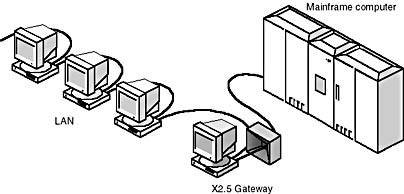
Figure 7.19 Mainframe gateways connect personal computers to mainframes
Gateway Considerations
Typically, gateways are dedicated servers on a network. They can use a significant percentage of a server's available bandwidth because they are carrying out resource-intensive tasks such as protocol conversion. If a gateway server is used for multiple tasks, adequate RAM and CPU bandwidth needs to be allocated or performance of the server functions will be degraded.
Gateways are considered as choices for implementation because they do not put a heavy load on internetwork communication circuits, and they perform specific tasks efficiently.
Lesson Summary
The following points summarize the main elements of this lesson:
- Modems make it possible to communicate over telephone lines.
- There are two types of modems: synchronous and asynchronous.
- It is important to choose the right cable when connecting hubs; crossover cables will not work in place of standard patch cables.
- Asymmetric digital subscriber line (ADSL) is a technology for increasing the speed of transmission on telephone lines.
- Repeaters are used to connect two segments of similar or dissimilar media and to regenerate a signal to increase the distance transmitted.
- Repeaters should not be used where network traffic is heavy, segments are using different access methods, or filtering is needed.
- Bridges have all the features of repeaters.
- Bridges are used to connect two segments to expand the length or number of nodes on the network, to reduce traffic by segmenting the network, or to connect dissimilar networks.
- Routers are used to connect two networks, limit unnecessary traffic, and to separate administrative networks.
- Brouters combine the features of bridges and routers; a brouter can act as a router for one protocol and as a bridge for all the others.
- Gateways perform protocol and data conversion.
- Gateways are limited in several ways: they are task-specific, expensive, and can be slow.
EAN: 2147483647
Pages: 106